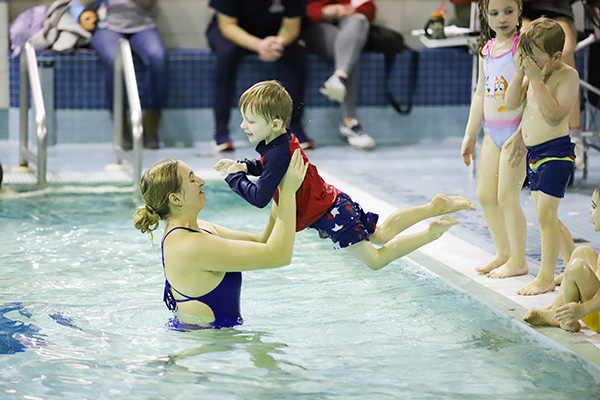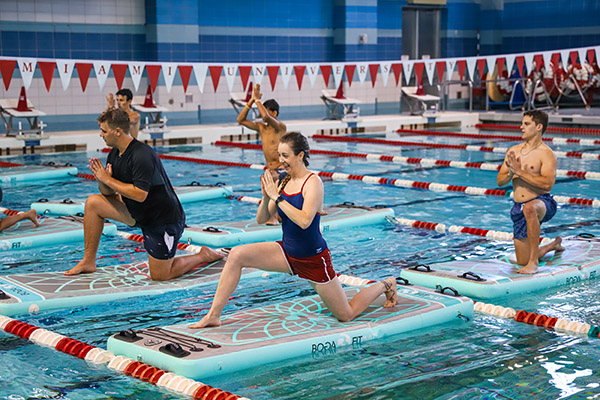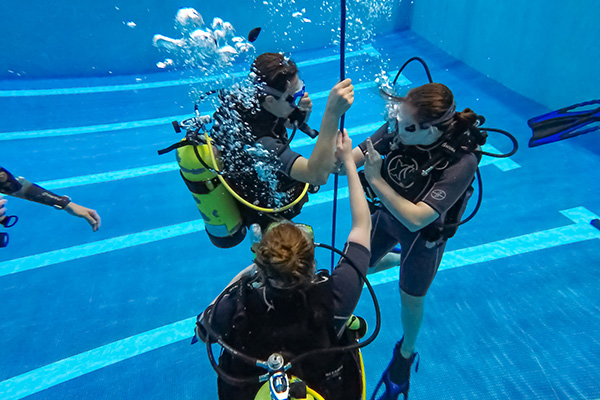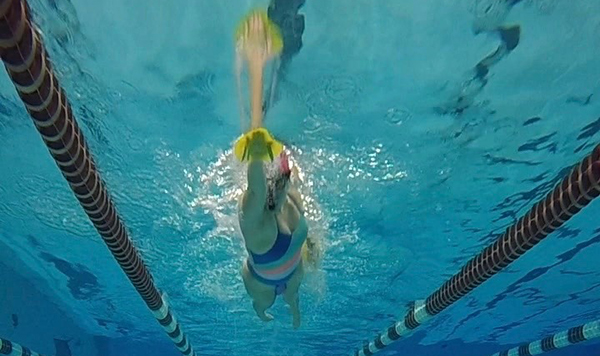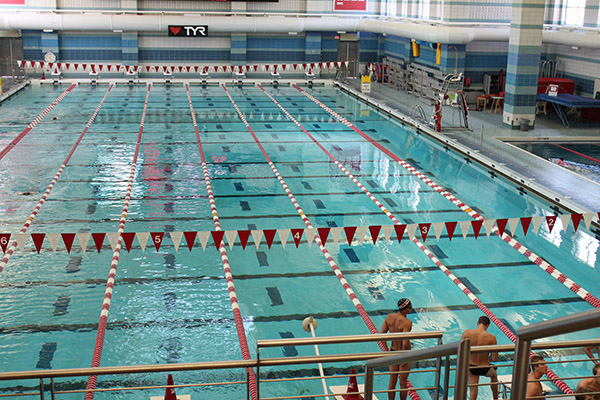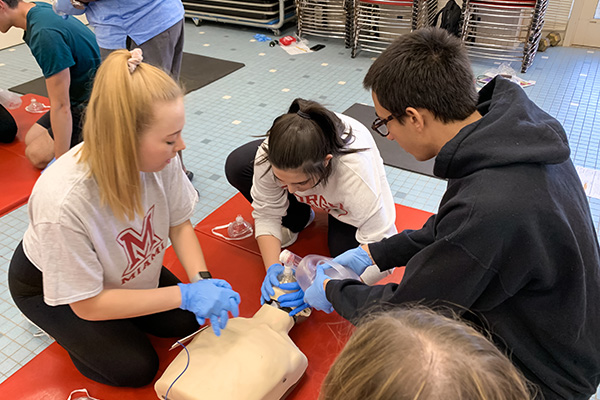
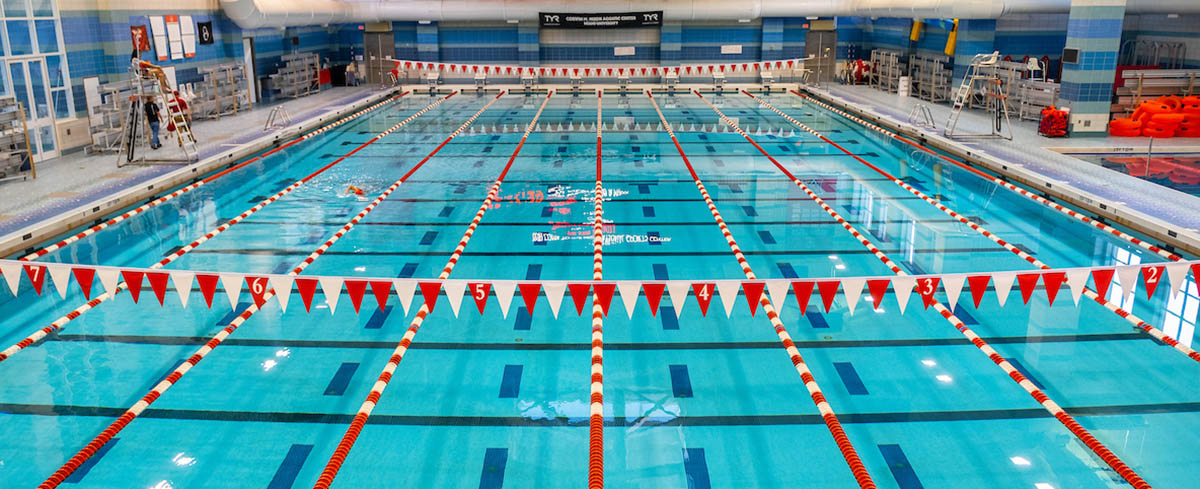
Aquatics
The Corwin M. Nixon Aquatic Center is a world-class aquatic center featuring an exceptional pool located in Oxford, Ohio, and serves as the venue for a variety of competitive swimming, diving, water polo, and synchronized swimming events throughout the year.
Explore Our Aquatic Center: Engage in Swimming, Fitness, and Relaxation
- The Aquatic Center is highlighted by an eight-lane, 50-meter pool, and a separate 25-meter dive well, containing 1m, 5m, 7.5m, and 10m platforms, a leisure pool, and a hot tub.
- Students, faculty, staff, and the community may take advantage of our numerous Aquatic related programs including Learn to Swim, Water Fitness, American Red Cross Safety Classes, Makos USA Swimming Competitive Swim Team, Masters Swimming, or just come in to relax in our pools and work off stress.
- Patio is open April 1-Oct. 31.
Aquatics Programs and Services
Pool Rules and Regulations
- Lifeguards have the responsibility to enforce all regulations and have the authority to remove anyone for any behavior that is deemed either unsafe or inappropriate.
- Children 14 years and under must be directly supervised (same activity area) by a paying (member or daily pass holder) parent or legal guardian at all times in the Rec. Infants are not to be left unattended and strollers are not permitted in activity areas.
- No Street Clothes of any kind are to be worn in the pool (This includes T-shirts over swimming suits)
- A soap shower is recommended before entering the water.
- Lifeguards have the responsibility to enforce all regulations and have the authority to remove anyone for behavior that is deemed either unsafe or inappropriate.
- The Emergency Alert System is two long whistle blasts and radio. All patrons will be instructed to exit the pool immediately.
- The use of any Miami University Aquatic facility is prohibited unless supervised by a Miami University Lifeguard or other certified Aquatic staff person(s).
- Blocking or restricting emergency exits is prohibited. Use of these exits without authorization is limited to emergency use only.
- No glass of any kind is allowed in the Aquatic Center, spectator gallery, or locker room.
- Hyperventilation is prohibited.
- Swim masks are not allowed for children or recommended for anyone. Adults are permitted to use them. Glass face plates are not permitted.
- The use of flotation devices is prohibited unless Coast Guard approved. This includes water wings, baby floats, inner tubes, etc.
- Restrictions on activities are limited to proper supervision and the general safety of all patrons.
- Running, pushing, shoving or horseplay is not permitted.
- Water polo or other water games which use a ball shall not be permitted in any of the pools without prior authorization from the aquatic office.
- Soft nerf/foam balls and small toys are allowed during Open Swim only. These toys must be used in a safe manner and not endanger any swimmer. Tennis balls, footballs, hard balls, squirt guns, etc. are not allowed.
- Patrons suspected to be under the influence of drugs and/or alcohol are not permitted to enter the pool.
- Hanging onto lane lines is not permitted.
- Eyeglasses may be worn in the pool only if they have plastic or safety glass lenses.
The dangers of breath holding are well known and well documented. The U.S. Naval Center website contains multiple examples of competent swimmers who lost their lives to shallow water blackout. Media outlets continue to highlight drowning of swimmers found unconscious, underwater following breath holding activities.
Industry groups including USA Swimming, the American Red Cross, the National Swimming Pool Foundation and the U.S. Navy have long cautioned against underwater breath holding activities, particularly those involving hyperventilation. Other groups, such as the YMCA of the USA and the Department of Morale, Welfare and Recreation of the U.S. Navy outright ban such extremely dangerous activities. Why? Because SWB has been proven to kill otherwise healthy swimmers.
When evaluating this from a risk management standpoint we can’t allow this type of practice to take place in the Recreational Sports Center.
The Recreational Sports Center has developed the following guidelines for all groups to follow when they are using the Miami University Aquatic Center as it relates to any type of breath holding activity while they are conducting training in the facility.
- Only allow one or two breaths prior to submersion. Shallow water blackout is linked to hyperventilation.
- Only allow underwater drills at the start of practice when swimmers are not close to their VO2 max.
- Only allow the distance of one length (25yds or m), one time. No repeats without adequate recovery time of at least 2:00. They could do a 25 underwater and then a 100 swim recovery before repeating with at least 2:00 RI between underwaters.
- The use of any devices that restrict movement of the arms or legs or is used to blindfold the eyes is prohibited.
- If these guidelines are not followed then that practice will be stopped at that point. Before the next practice can resume the coaches involved will meet with John Mihevic and Terri Shannon to go over the policy again and what steps are going to be taken so this would not happen again.
- In the event this happens a second time the coaches and their respective A.D. will have to meet with the Aquatics Director and the Associate Director before any further practices can occur.
Glossary of Terms
- Shallow water blackout (“SWB”), also referred to as hypoxic blackout, is a term describing loss of consciousness arising from oxygen deprivation brought about by voluntary or involuntary hyperventilation.
- In swimming, voluntary hyperventilation occurs when a swimmer intentionally “overbreathes,” blowing off carbon dioxide.
- Involuntary hyperventilation can occur as a result of stress and physical exertion during a workout that pushes the swimmer beyond his/her maximum aerobic capacity (VO2 max).
We strive to provide a safe and competitive environment for all of the teams that use this facility. If you have any questions regarding this policy or any other policies in the Miami University Aquatic Center please contact Terri Shannon or John Mihevic.
- No Diving. Feet first entry only.
- No swimming under the bulkhead at any time.
- Swim only in the designated swim lanes.
- Swimming is only permitted during posted hours in designated lap lanes and during water fitness classes.
- All individuals may be asked to show ability to swim as requested by the lifeguard.
- Diving from the side allowed in designated lap lane areas only or in other parts as determined safe by the lifeguard.
- Tower access door must remain locked when no guard is on duty and until authorized group arrives
- Outside boards are designated for recreational diving
- Patrons able to swim may use 1 and 3 meter boards
- Only one person is allowed on each diving board. Patrons must wait at the bottom of the stairs when using springboards
- Spring board fulcrum is to remain at level 1 during rec dive
- Patrons are to exit at the nearest ladder after going off the boards. Patrons who wish to remain in the water must enter the swim lanes
- Only one bounce on spring boards allowed
- Individuals must go straight off board
- Lifejackets are permitted to wear while going off the boards
- Prohibited Dives during Rec Diving:
- Inwards and reverse dives
- Backflips (back dives are okay)
- Handstands
- Sit down dives
- Sailor dives (head first, arms at side)
- Any dive which brings the head back toward the board
- Diving deemed unsafe, in the judgment of the lifeguard, will be prohibited.
- Sparger & Harness may be used by an approved coach only and if noted on the contract.
- Sparger cannot be used during open recreational swimming/diving or when other aquatic programs are in the water
- Sparger can only be used during an exclusive use of the dive well
- Harness may only be used on the outside 1 meter springboard and access is limited to ONLY approved diving coaches
- Diving is not allowed in the leisure pool area.
- Patrons may only enter and exit at walls without railings.
- Maximum number of patrons allowed in the leisure pool is 75.
- Demonstration of swimming ability must be performed at the request of the lifeguard.
- Only Coast Guard approved flotation devices are to be used.
- Patrons are not allowed to walk on or jump over any islands.
- Sinking aides such as rubber bricks, rings and pucks are acceptable with proper use during open swim, as determined by the lifeguard(s) on duty. Rocks or metal objects that will rust are not permitted.
- No shooting from the hot tub or deck.
- No basketball during water fitness or LTS classes.
- No hanging on the basketball rim.
- All shots must be taken within the blue line area from the goal for safety.
- Patrons may not raise or lower the rim.
- Use of the whirlpool is restricted to those 8 years or older.
- Children 8—12 years old may use the whirlpool during the first 15 minutes of every hour.
- Children may be asked to leave if their actions are considered disruptive or unsafe.
- Patrons are recommended to limit their use to no more than 15 minutes.
- Maximum Capacity is 12 people.
- Patrons may not use whirlpool if the temperature is not between 102-104 degrees F.
- No walking on top of the whirlpool walls.
- Use of the whirlpool includes all body parts (for example, a patron sitting with just his feet in the whirlpool is still using the whirlpool.)
Please Be Advised: Learn to Swim and Dive Lessons
- The Minimum enrollment for any group lesson is 3 students.
- Classes not meeting the minimum will be canceled or combined before the first scheduled lesson.
- If the session is canceled by Miami University, a full refund will be issued.
- There will be no make-up lessons and no refunds will be given for missed classes.
- Any photographs taken by Learn to Swim Staff become the property of Miami University Recreational Sports Center.
- These photos may be used in future promotional material.
Contact Us
Miami Recreation
About
Miami Recreation Services proudly serves the Miami and Oxford community with state-of-the-art fitness facilities, quality programming for all ages and exceptional customer service. We offer programs for fitness, sports, equestrian, aquatics, outdoor adventures, food and drink sales, facility rentals, and informal recreation with the same goal: enhancing the physical, mental, and social well-being of the community.
